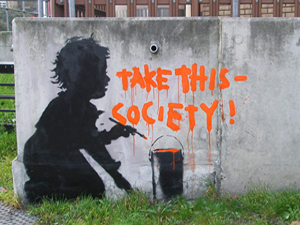
“One day, when I was quite young,” my friend Wendy once wrote, “I saw a graffittied stop sign saying, ‘stop thewar,’ and I spent two days trying to figure out what thew ar was.”
Wendy’s recollection has always reminded me of a story of my own. One day at the age of thirteen, I was waiting in line for a ride at an amusement park. I noticed that somebody had carved onto a wooden post the words, “Jesus is Bord!” I had no idea what that meant, and I kept wondering what this person was trying to say. Maybe it was something as profound and as bleak as, “Jesus has lost all interest in our silly human games.” Or perhaps it was more of a blasphemous non sequitur like, “I am Jesus, and I am sick of waiting in this long line.” It wasn’t until three months later that I realized that the most likely story pointed to two authors: one to write the original message of “Jesus is Lord,” and a second one to carve a capital B out of the letter L. The world seems far more mundane once you take the mystery out of graffiti in public places.
It’s the excitement of the mystery, anonymity, and raw emotion behind graffiti that makes it so intriguing. I have never felt passionately enough to deface a public surface with a drawing or an earnest opinion, but I often wonder what goes through the minds of those people who do. Surely they understand that you can’t change the world by writing on a wall, don’t they? Perhaps they do understand that, but sometimes the most important thing is merely knowing that somebody somewhere can hear you. That’s almost admirable in an idealistic, sentimentally quixotic sort of way. Graffiti is vandalism, and I sure as hell don’t want anybody spraying up my house or my fences, but there’s something so primal and so urgent about it that I just can’t deny the inexorable humanity of it all. Sometimes the desire to be heard outweighs common sense and common courtesy. Sometimes graffiti is fucking cool.
Amongst rapper Mos Def’s many memorable rhymes, an excerpt from his song, Speed Law, has always stuck with me:
Get your power, your masks and capes snatched
Brooklyn take what you can’t take back
I know a lot of cats hate that
All I can say black
There’s a city full of walls you can post complaints at
Perhaps it’s silly of me to romanticize the vandalism of public and private property. Graffiti, after all, is obnoxious. It’s selfish and unsightly and invariably offensive to somebody. It’s the human equivalent of urinating on a tree to mark your presence. Although there is a growing movement of legitimate graffiti artists who have turned the medium into a viable art form, and although some disenfranchised idealists have written some powerful things on public walls over the years, the vast majority of the world’s graffiti amounts to hateful smut or hackneyed catch phrases. I guess as in all things in life, our only recourse is to tolerate the bad along with what little good there is to find.

Like it or not, the desire to be heard is a universal human constant — a necessity like laughter, friendship, water, and air. It is a deeply ingrained need that both inspires and taints the human heart. When Simon & Garfunkel sang about the words of the prophets written on the subway walls, they were tapping into the human desire to be heard in a paradoxical world where people struggle to communicate, all the while the technology enabling mass communication steadily improves. We have our blogs and our special interest forums and our Facebook accounts, but there’s no substituting a blank wall facing a busy street. We pee wherever the hell we want to pee because we are human beings, goddamn it, and we have a right to be heard. Just stay the fuck off my lawn and write on my neighbors’ walls, okay, humanity?

I personally have found it impressive where some people are even able to do their graffiti. Pretty ballsy places to hang down from if you ask me. These people are real mavericks.
http://failblog.org/2008/11/14/wall-fail/